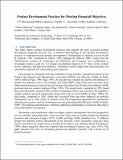| dc.description.abstract | This paper reports product development practices that separate the most successful product development programs from the rest. A detailed understanding of best product development practices is important because product development is fundamental to corporate success (Clark & Fujimoto, 1991; Eisenhardt & Tabrizi, 1995; Eppinger & Chitkara, 2006). Teams from the Massachusetts Institute of Technology and McKinsey and Company have collaborated to investigate practices used for 112 product development projects at 57 firms in the medical device, industrial, and high-tech industries. Preliminary results suggest that certain practices are particularly important for influencing project outcomes. Our research is consistent with and contributes to best practices reported previously by the Product Development and Management Association (PDMA) (see Barczak, Griffin, & Kahn, 2009; Griffin & Page, 1996; Page, 1993). As this previous research has shown, best practices in product development evolve. For example, the 1990 PDMA study found that successful firms differentiated themselves from the rest by having well defined New Product Development (NPD) processes and new product strategies (Page, 1993). The second study, conducted in 1995, found that successful firms measured their product development efforts and outcomes, did qualitative market research, and used engineering design tools such as CAD (Griffin & Page, 1996). The third study, completed in 2003, found that successful firms put more emphasis on portfolio management, use a wide variety of software tools, have supporting organizational mechanisms and processes in place, and use formal processes for generating ideas (Barczak, Griffin, & Kahn, 2009). The findings presented here contribute additional understanding of practices that lead to successful product development. Researchers and practitioners often investigate product development from the perspectives of cost, schedule, and performance. There are many more ways to evaluate product development processes and outcomes (Cooper, 1979). Griffin and Page (1996) identified over 75 different product development metrics documented in the literature. Some researchers categorize these metrics into firm level, project level, or product level metrics (e.g. Montoya-Weiss & Calantone, 1994); others categorize them into financial and non-financial metrics (e.g. Hart, 1993). This paper presents our work on correlating product development practices with a broad set of financial metrics. | en_US |
